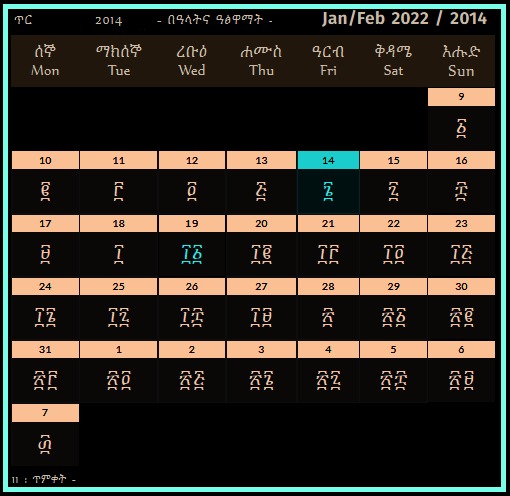
Why Is It 7 to 8 Years Behind?
Ethiopia is ultimately considered one of the most scenically beautiful African countries blessed with rare wildlife, deserts, historical and archaeological wonders, an amazing culture, and much more. One fascinating aspect of Ethiopia’s culture is their use of a 13-month calendar that is about 7 to 8 years behind the rest of the world, which mostly uses the Western Gregorian calendar. One could even say a visit to Ethiopia is like taking a trip back in time because it is literally 2014 over there per their calendar. This came to be as a result of Ethiopia being free from any influences from the Roman Church and colonial rulers who encouraged the adoption of the Gregorian calendar in various parts of the world, allowing Ethiopia to easily retain its original calendar.
This ancient calendar has been in existence for over 2000 years. It is the principal calendar used in both Ethiopia and Eritrea to date, making Ethiopia one of the few countries in the world which uses its own calendar system. It is alternatively known as the Ge’ez calendar (Ge’ez is the ancient language of Northern Ethiopia and Southern Eritrea), and is derived from the Egyptian solar calendar but adds a leap day every 4 years. The calendar consists of 13 months, 12 of which comprise 30 days, and the 13th month called ‘Pagume’ has about 5 or 6 days in a leap year. The calendar begins with the Incarnation (birth) of Yeshua in the year 7 BC, according to the Ethiopian Orthodox Church. The Gregorian calendar is also based on the birth of Yeshua but places his birth in AD 1, which explains the gap of about 8 years between the start of both calendar years.
The Ethiopian calendar’s ties to Biblical figures and anecdotes are prominent in the names of the days of the week and months, as well as the calendar’s 4 year leap year which is associated with four disciples of Yeshua; Matthew, Mark, Luke, and John. For instance, the first year after an Ethiopian leap year is known as the John year, followed by the Matthew year, then after coming the Mark year, and lastly, the leap year is traditionally designated as the Luke year. Also, most major holidays like Christmas and New Years’ are celebrated on days that are different from the rest of the world i.e. January 7 and September 11 or 12 respectively. Sunrise and sunset are at different times as well, so 6 am in the morning in other places of the world will be 12 am, and 6 pm is 12 pm in Ethiopia.
Although modern-day Ethiopia still embraces its traditional calendar, most Ethiopians know about the Gregorian calendar and some even use both calendars interchangeably. To foreigners, it may seem strange and difficult to understand or adapt to, but to Ethiopians, it is their norm. As the saying goes ‘When in Rome, do what the Romans do.’ This unique aspect of Ethiopia’s culture makes it a very fascinating country to visit and experience because it doesn’t end here, believe me.



